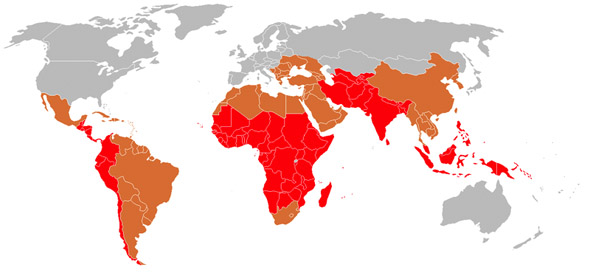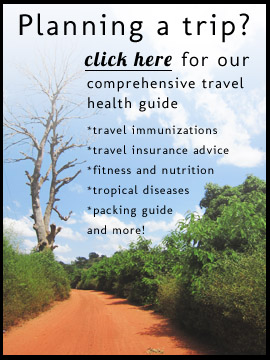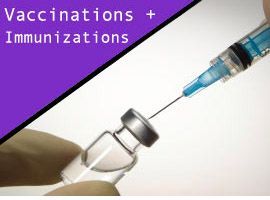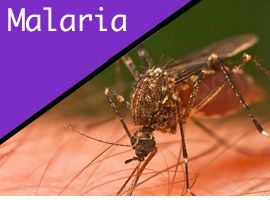Outside of the developed world, typhoid is found almost everywhere. Thankfully, it is rarely fatal if treated, and there are easy-to-take preventative measures like getting vaccinated. In addition to prevention, this post will also look at signs and symptoms and treatment.
Where is typhoid found?
See the map below. Grey indicates little to no risk. Red indicates the highest prevalence.

How is typhoid transmitted?
Typhoid is caused by the bacterium Salmonella Typhi. The bacteria is carried by infected persons in the blood stream and GI tract. As far as how it spreads, well, you’re not going to like this part. The bacteria exits an infected person via their stool. Then, another person ingests some of that person’s.. you get the idea.
How does this happen? Most transmissions are caused by contaminated food or water. For example, if sewage somehow finds its way into the water supply or if a restaurant or food vendor is not preparing meals in a hygienic manner.
Signs and symptoms
- Fever – typically progresses slowly, can reach 40 °C (104 °F)
- Stomach and abdominal pain – can also be accompanied by diarrhea or constipation
- Lethargy and malaise – general feelings of weakness
- Lack of appetite
- Aches and pains – a persistent headache is common as are generalized, flu-like aches
- A rash – in a small percentage of cases, patients develop a rash of rose-colored spots, typically on the abdomen or chest.
In some cases, nosebleeds and bloody stools can occur. In rare cases, severe complications can arise, such as intestinal hemorrhaging and intestinal perforation.
These symptoms seem very similar to the flu. How do you know it’s typhoid?
Outside of a blood test and a stool analysis, you won’t know for sure. If you are experiencing the above symptoms in a place where typhoid is present, you should go to a clinic for a proper diagnosis.
Prevention
Typhoid is vaccine preventable. As we mentioned in our article on travel vaccinations and immunizations, the typhoid vaccination is regularly recommended by doctors at travel health clinics. It’s also endorsed by the US Centers for Disease Control.
The vaccine is available in a round of oral doses or as a single injection. The oral vaccine requires a booster every 5 years while the injection requires a booster every 2 years. For more information on the typhoid vaccine and for detailed instructions on finding a travel health clinic where you can have the appropriate consultation, see our article on travel immunizations here.
Like most vaccines, it does not guarantee immunity. This means you also need to watch what you eat and drink, and always make sure your hands are washed before preparing food or eating. See our tips for preventing traveler’s diarrhea as many of them apply for typhoid as well.
Typhoid treatment
Typhoid is treatable with a number of antibiotics. Ciprofloxacin, ampicillin, and trimethoprim-sulfamethoxazole are the most commonly prescribed. A doctor will prescribe the appropriate antibiotic given your situation (for example, cipro won’t be prescribed if you are a pregnant woman). Typically, patients begin to see relief in 2 to 3 days. In some cases, fluids are supplied by IV if the patient is especially dehydrated.
The success rate for proven treatment methods is close to 100%. Untreated, typhoid can last for several weeks and in some cases (approximately 20%), infected persons die from complications.
Other things to keep in mind
Relapse is possible. Typhoid has been to known to relapse even after a course of treatment. If symptoms recur, get to a clinic as soon as possible. You may be prescribed different antibiotics or a higher dose. To ensure treatment was effective, you can get a stool analysis (not the most fun thing to do, but provides some valuable information).
Keep typhoid to yourself. What we mean to say is, if you have or have recently had typhoid, make sure to keep your hands clean and be especially mindful if you are handling food for others. Typhoid needs a human host; there is a lot we can do to curb its prevalence by changing our behavior.
If you’ve had typhoid before, please share your experience in the comments below.
Photo credit: Global X












{ 3 comments… add one }